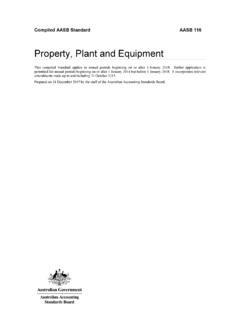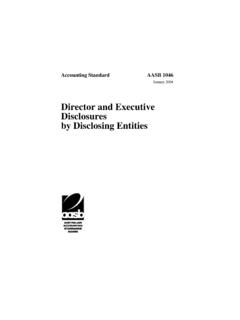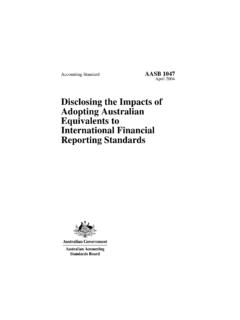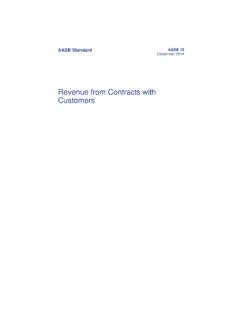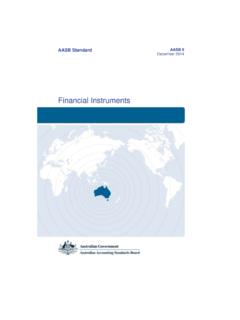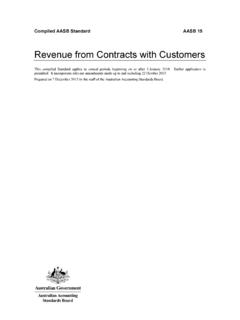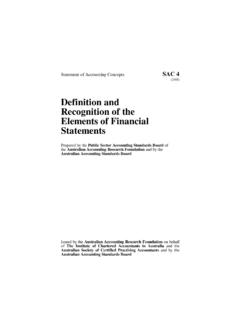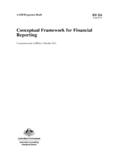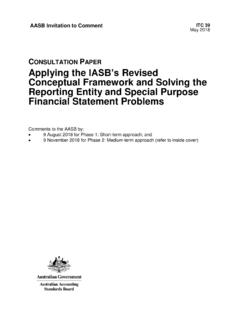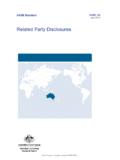Transcription of AASB IFRS Based Standard
1 aasb Standard aasb 119 September 2011 Employee Benefits aasb 119 2 COPYRIGHT Obtaining a Copy of this Accounting Standard This Standard is available on the aasb website: Alternatively, printed copies of this Standard are available for purchase by contacting: The Customer Service Officer Australian Accounting standards Board Level 7 600 Bourke Street Melbourne Victoria AUSTRALIA Postal address: PO Box 204 Collins Street West Victoria 8007 AUSTRALIA Phone: (03) 9617 7637 Fax: (03) 9617 7608 E-mail: Website: Other Enquiries Phone: (03) 9617 7600 Fax: (03) 9617 7608 E-mail: COPYRIGHT Commonwealth of Australia 2011 This aasb Standard contains ifrs Foundation copyright material. Reproduction within Australia in unaltered form (retaining this notice) is permitted for personal and non-commercial use subject to the inclusion of an acknowledgment of the source.
2 Requests and enquiries concerning reproduction and rights for commercial purposes within Australia should be addressed to The Director of Finance and Administration, Australian Accounting standards Board, PO Box 204, Collins Street West, Victoria 8007. All existing rights in this material are reserved outside Australia. Reproduction outside Australia in unaltered form (retaining this notice) is permitted for personal and non-commercial use only. Further information and requests for authorisation to reproduce for commercial purposes outside Australia should be addressed to the ifrs Foundation at ISSN 1036-4803 aasb 119 3 CONTENTS CONTENTS PREFACE COMPARISON WITH IAS 19 INTRODUCTION TO IAS 19 (available on the aasb website) ACCOUNTING Standard aasb 119 EMPLOYEE BENEFITS Paragraphs Objective 1 Application Scope 2 7 Definitions 8 Short-term employee benefits 9 10 Recognition and measurement All short-term employee benefits 11 12 Short-term paid absences 13 18 Profit-sharing and bonus plans 19 24 Disclosure 25 Post-employment benefits.
3 Distinction between defined contribution plans and defined benefit plans 26 31 Multi-employer plans 32 39 Defined benefit plans that share risks between entities under common control 40 42 State plans 43 45 Insured benefits 46 49 Post-employment benefits: defined contribution plans 50 Recognition and measurement 51 52 Disclosure 53 54 Post-employment benefits: defined benefit plans 55 Recognition and measurement 56 60 Accounting for the constructive obligation 61 62 Statement of financial position 63 65 Recognition and measurement: present value of defined benefit obligations and current service cost 66 Actuarial valuation method 67 69 aasb 119 4 CONTENTS Attributing benefit to periods of service 70 74 Actuarial assumptions 75 80 Actuarial assumptions: mortality 81 82 Actuarial assumptions: discount rate 83 86 Actuarial assumptions: salaries, benefits and medical costs 87 98 Past service cost and gains and losses on settlement 99 101 Past service cost 102 108 Gains and losses on settlement 109 112 Recognition and measurement.
4 Plan assets Fair value of plan assets 113 115 Reimbursements 116 119 Components of defined benefit cost 120 122 Net interest on the net defined benefit liability (asset) 123 126 Remeasurements of the net defined benefit liability (asset) 127 130 Presentation Offset 131 132 Current/non-current distinction 133 Components of defined benefit cost 134 Disclosure 135 138 Characteristics of defined benefit plans and risks associated with them 139 Explanation of amounts in the financial statements 140 144 Amount, timing and uncertainty of future cash flows 145 147 Multi-employer plans 148 Defined benefit plans that share risks between entities under common control 149 150 Disclosure requirements in other Australian Accounting standards 151 152 Other long-term employee benefits 153 154 Recognition and measurement 155 157 Disclosure 158 Termination Benefits 159 164 Recognition 165 168 Measurement 169 170 Disclosure 171 aasb 119 5 CONTENTS Transition and Effective Date 173 DELETED IAS 19 TEXT Page 63 BASIS FOR CONCLUSIONS ON IAS 19 (available on the aasb website) Australian Accounting Standard aasb 119 Employee Benefits is set out in paragraphs 1 173.
5 All the paragraphs have equal authority. Paragraphs in bold type state the main principles. aasb 119 is to be read in the context of other Australian Accounting standards , including aasb 1048 Interpretation of standards , which identifies the Australian Accounting Interpretations. In the absence of explicit guidance, aasb 108 Accounting Policies, Changes in Accounting Estimates and Errors provides a basis for selecting and applying accounting policies. aasb 119 6 PREFACE PREFACE Introduction The Australian Accounting standards Board ( aasb ) makes Australian Accounting standards , including Interpretations, to be applied by: (a) entities required by the Corporations Act 2001 to prepare financial reports; (b) governments in preparing financial statements for the whole of government and the General Government Sector (GGS); and (c) entities in the private or public for-profit or not-for-profit sectors that are reporting entities or that prepare general purpose financial statements.
6 aasb 1053 Application of Tiers of Australian Accounting standards establishes a differential reporting framework consisting of two tiers of reporting requirements for preparing general purpose financial statements: (a) Tier 1: Australian Accounting standards ; and (b) Tier 2: Australian Accounting standards Reduced Disclosure Requirements. Tier 1 requirements incorporate International Financial Reporting standards (IFRSs), including Interpretations, issued by the International Accounting standards Board (IASB), with the addition of paragraphs on the applicability of each Standard in the Australian environment. Publicly accountable for-profit private sector entities are required to adopt Tier 1 requirements, and therefore are required to comply with IFRSs.
7 Furthermore, other for-profit private sector entities complying with Tier 1 requirements will simultaneously comply with IFRSs. Some other entities complying with Tier 1 requirements will also simultaneously comply with IFRSs. Tier 2 requirements comprise the recognition, measurement and presentation requirements of Tier 1 but substantially reduced disclosure requirements in comparison with Tier 1. Australian Accounting standards also include requirements that are specific to Australian entities. These requirements may be located in Australian Accounting standards that incorporate IFRSs or in other Australian Accounting standards . In most instances, these requirements are either aasb 119 7 PREFACE restricted to the not-for-profit or public sectors or include additional disclosures that address domestic, regulatory or other issues.
8 These requirements do not prevent publicly accountable for-profit private sector entities from complying with IFRSs. In developing requirements for public sector entities, the aasb considers the requirements of International Public Sector Accounting standards (IPSASs), as issued by the International Public Sector Accounting standards Board (IPSASB) of the International Federation of Accountants. Differences between this Standard and aasb 119 (December 2004, as amended) Differences between this Standard and the superseded requirements under aasb 119 (December 2004, as amended) are the same as the differences between IAS 19 Employee Benefits (June 2011) and the superseded requirements under IAS 19 Employee Benefits. The main differences are summarised in the project summary and feedback statement in relation to amendments to IAS 19 Employee Benefits, which is available on the IASB s website at Reduced disclosure requirements Disclosure requirements under Tier 2 have been determined through a separate due process see aasb 2011-11 Amendments to aasb 119 (September 2011) arising from Reduced Disclosure Requirements.
9 aasb 119 8 COMPARISON COMPARISON WITH IAS 19 aasb 119 Employee Benefits incorporates IAS 19 Employee Benefits issued by the International Accounting standards Board (IASB). Paragraphs that have been added to this Standard (and do not appear in the text of IAS 19) are identified with the prefix Aus , followed by the number of the preceding IASB paragraph and decimal numbering. Paragraphs that apply only to not-for-profit entities begin by identifying their limited applicability. Entities that comply with aasb 119 will simultaneously be in compliance with IAS 19. aasb 119 9 Standard ACCOUNTING Standard aasb 119 The Australian Accounting standards Board makes Accounting Standard aasb 119 Employee Benefits under section 334 of the Corporations Act 2001.
10 Kevin M. Stevenson Dated 5 September 2011 Chair aasb ACCOUNTING Standard aasb 119 EMPLOYEE BENEFITS Objective 1 The objective of this Standard is to prescribe the accounting and disclosure for employee benefits. The Standard requires an entity to recognise: (a) a liability when an employee has provided service in exchange for employee benefits to be paid in the future; and (b) an expense when the entity consumes the economic benefit arising from service provided by an employee in exchange for employee benefits. Application This Standard applies to: (a) each entity that is required to prepare financial reports in accordance with Part of the Corporations Act and that is a reporting entity; (b) general purpose financial statements of each other reporting entity; and (c) financial statements that are, or are held out to be, general purpose financial statements.
